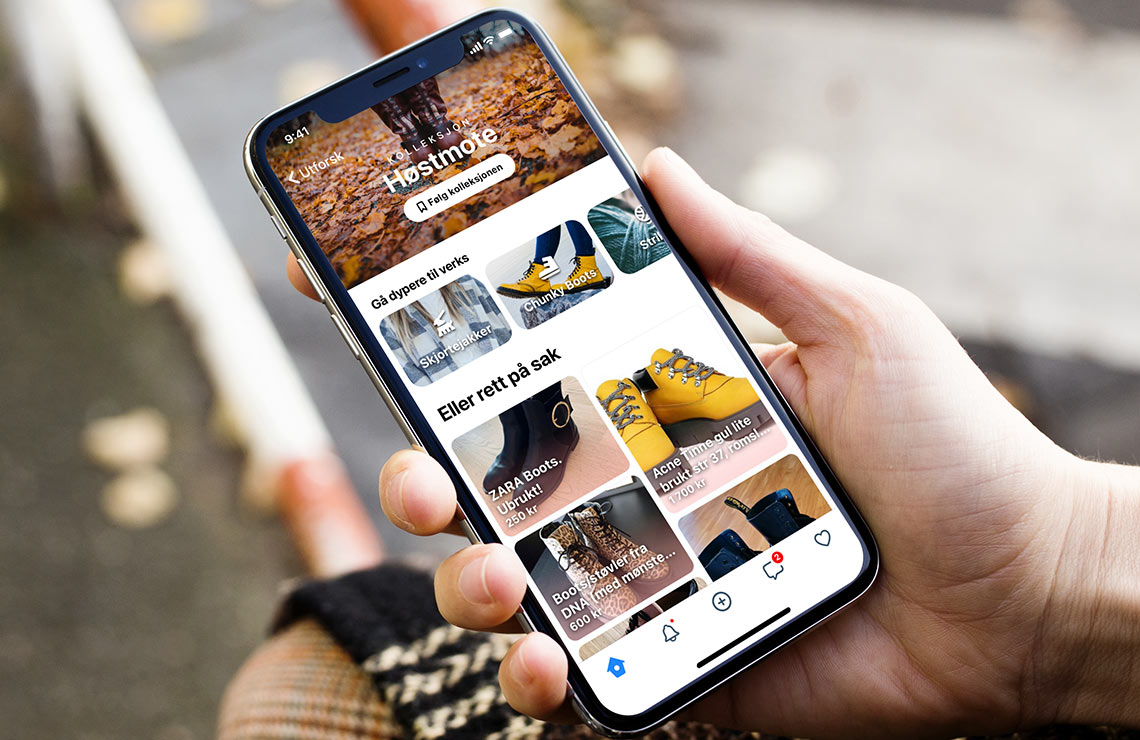
An inspiring experience will attract Gen Z
Gen Z are accustomed to defining their own tastes, trends, and values. Most of their screen time is spent inside the big social media apps, where new shopping habits, ways of learning, and trends are emerging. Anniken Ore Larssen is part of a team that is investigating how Finn can meet their needs.
Since January 2020, I’ve been working with a small team at Finn to create a new marketplace experience tailored to the needs of Gen Z. With this we hope to meet Gen Z’s need for inspiration, creativity, and speed. The result is a separate app, launched as an open beta this fall, which gives us the opportunity to iterate and learn fast without annoying Finn’s usual users.
And there is a lot to learn.
As a 28-year old having researched Gen Z for more than a year, I have only one conclusion: I’m feeling old. If I was asked to describe them with just one word it would be impatient. Everything seems to move a bit faster with this generation.
The fact that they have grown up with everything digital, social, and app-based has radically increased the pace of scrolling, liking and sharing. I encourage you to observe this next time you sit next to a teenager on the bus.
High expectations
Being online ”almost constantly” has not only led to a completely different way of navigating, it has raised Gen Z’s expectations of digital services. This also changes their relationships to peers, brands, and influencers. While it is said that Gen Z’s attention span is only 8.3 seconds (down from 12 for millennials), they are good at filtering out what’s important information. They quickly make decisions about what and whom get their attention and time.
Gen Z also has a different way of expressing themselves versus previous generations. With the rise of stories, snaps and six-second Tik Tok videos, things are moving faster. Not only does the aesthetic seem rawer, as we can see in clothing (think Billie Eilish), and photo editing (or lack thereof), also their message has an impatient, rebellious vibe.
They are vocal about their values, the labels they want you to use, and they will call you out if you do something that doesn’t match their expectations.
You might know the creative sides of Gen Z best through memes, snap filters, and Tik Tok videos. Snapchat even names them the generation of super-creatives, and their own research shows that more than half of respondents engage in what we would call creative activities both online and offline (drawing, making music, taking photos, sowing and redesigning). They are constantly on the lookout for new inspiration and new things to learn.
Self-expression is taken to the next level by launching fashion brands on Instagram, enabled by simple, no-code tools such as Shopify and Wix. It has made it possible for Gen Z to act on trends and to influence what’s cool in completely new ways. We can see it in an array of side hustles and smaller entrepreneurial efforts. As quoted by a Gen Z representative in a video by i-D magazine: ”Everyone has a t-shirt brand nowadays”.
I can imagine that Gen Z’s impatience and creativity will be visible in the job market in a few years, for instance by working several jobs simultaneously. Some will do this for a predictable income, while others will do it to fulfill their creative needs, applying this DIY (do it yourself) mentality to their careers as well.
Finding the best deal
Where consumption habits of previous generations might have been more or less dictated by advertising, Gen Z researches several sources to find the best deal. They consult friends, youtubers, and reviews before making a buying decision that is supported both by their wallet and their values.
Big corporations are trying to capitalize on this, such as through influencer marketing. But more importantly, platforms that were previously meant for inspiration only, are now gradually claiming a larger part of the buying journey. The best example of this is Instagram. I’m sure you’ve seen the white dots on some images, showing price tags when you click on them, or the new shops tab in the explore feed.
So, what are we going to do with all this information about Gen Z? In Schibsted, most of our brands grew up over the last 20 years – just like Gen Z. But it seems that this generation’s expectations are outgrowing us. With all this impatience and all this speed, can we, as a big organization, continue to develop products at our usual pace? This is why we started the Finn project and why we made it into a fast-paced process of testing hypotheses with real users during every two-week sprint. Our main idea is that Finn needs to make a similar journey to what Instagram has made – but the other way around. As just mentioned, Instagram is moving towards transaction. We believe that Finn, which has been a place purely for buying and selling, needs to move towards inspiration.
Therefore, we are looking at ways to combine editorial and marketplace content for a new and inspiring experience. We hope that user behaviour will change from using Finn only when you need something specific, to opening the app just to check what’s new, to be able to discover something you like. We want to make it quick and intuitive to find what you’re looking for and learn how to make sustainable choices.
I’m not going to claim we have found the solution to Gen Z’s needs yet. I believe it is a continuous process of testing and evolving, just like they do.

Anniken Ore Larssen
Product Manager
Years in Schibsted
3
What I’ve missed the most during the Corona crisis
Hugging my grandparents